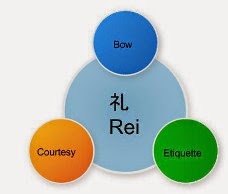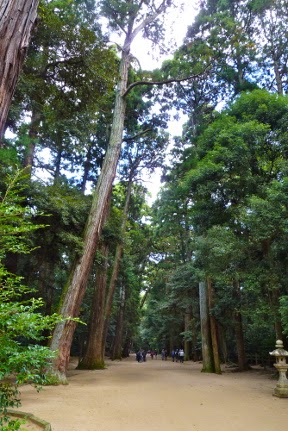Over the weekend, I had the great pleasure to attend an excellent seminar in a martial art well outside my own practice. I do Kodokan Judo, Shinto Hatakage Ryu Iai Heiho and Shinto Muso Ryu Jo. The seminar was focused on basic movements and exercises of Daito Ryu Aikijujutsu. This is an art I know next to nothing about. The movements and techniques are quite different from anything in Judo or Iai or Jo. Why would I bother spending a weekend on something so unrelated to what I train?
I spend a lot of time focused on improving my skills at the arts I do, so it may not make a lot of sense to take that time away from my primary arts and do something I'm not planning to on doing regularly. For me though, it makes a lot of sense.
There is no such thing as a complete martial art. Is boxing or jujutsu complete? Boxing doesn't include grappling and jujutsu doesn't do much with strikes. MMA prohibits a lot of techniques that could cause permanent injury or cripple. Judo includes some strikes, but ignores joint locks except for the wrist, elbow and shoulder (and one knee lock!). Which one is most complete? There's a problem even there though. The question asks which is “most complete” and not “which is complete?” Many classical arts also teach a variety of weapons in addition to empty hand techniques. Takenouchi Ryu, Sousuishi Ryu, Kashima Shinryu, and others teach a variety of weapons, including swords, spears, staves and nasty things with chains.
Even these though aren't complete. None of them teaches extensive unarmed strikes and none includes firearms. Maybe the solution is to study military or police combatives and weapons. Even then you won't get a complete system. Military combatives tend to focus on killing the enemy. Police combatives tend to focus on not doing unnecessary damage. Neither makes an pretense of being complete. Their training is highly focused for specific types of situations. Not complete, but just the opposite, they are very focused one subset of scenarios.
With all the possibilities that exist, there isn't enough room in one lifetime to become competent in everything. We have to choose what we are going to specialize in. That's OK, and it's certainly better than trying to learn everything. That would spread your training time so thin that you'd never be any good at anything. So you limit what you study intensively. Even when you put limits on what you're going to try to master, you don't have to put limits on being aware of other options.
 |
| Me, learning about a whole new way to lock up shoulders. Photo Copyright 2015 Masami Mitsusada |
Going to seminars outside your art is great for learning what else is available, and how other arts use their skills to address questions similar to what your own art addresses. A question as simple as “how do you deal with a strike?” gets complicated very quickly. Even just within Judo we have multiple options with a range of effects from simple arm bars, to counter strikes with arm bars, chokes, and multiple types of throws. That's just within in one art. The Karate guys have a number of options that Judo never even considers. Blocks and counter strikes of all sorts. We haven't even started to consider some of the koryu arts that include numerous weapons that might be appropriate.
Different arts frame the question of dealing with particular attacks and situations differently. In Judo, the first response to most attacks is a throw, and after we've explored that, then we'll think about chokes and arm bars. Karateka tend to prefer a hard block and multiple strike response to the same situation. Classical jujutsu styles often use a combination of counter strike followed by dashing their foe into the ground. Aikido might use a smooth blend with the attack followed by a wicked deconstruction of one or more joints.
 | |||
| Me getting an education from Howard Popkin Sens |
If you only practice your own art, and never try anything else, you won't really know how broad the options are for dealing with any given scenario. Worse, you can fall into the trap of thinking whatever you do is superior. Martial arts are very Darwinian. Only the ones that have some effectiveness in real situations tend to survive. If someone else does things differently, and they continue to draw students, especially students with backgrounds in law enforcement or similar professions, they probably offer something real.
Being exposed to techniques and exercises that I don't encounter in my regular practice can aid my development. If you don’t have any idea of what the range of possibilities are, and how they work, your own training is very incomplete. If you don’t know how things really happen, you’re training is going to reflect your best guesses. Those guesses are likely to be wrong. In Judo, we have a number of techniques for use versus weapons. Most judoka don’t have any idea how to use those weapons (knives, swords and sticks) effectively, so it’s impossible to train well against them. As it happens, I also do iai and jo, so I bring that experience with me to my judo training. Swords and sticks are remarkably fast weapons, faster than most people imagine. The average judoka training against weapons in the Kime No Kata doesn’t understand just how far they have to be from the sword or stick to have a chance of reacting before it reaches them.That’s clear from watching they way they train. After years of ia i and jo, that is a mistake I don’t make.
If you’ve never experienced something, and no one you’re training with has ever experienced it, the odds of you doing that training properly approach nil. Years ago, before I really understood this lesson, I had many conversations with a friend who has considerably more experience than I do in many areas. He would make a declaration and I, naively, would reject his claims. Then he’d proceed to demonstrate the narrow limits of my experience and understanding by throwing me across the room or tying me into knots. Chuck had learned his arts deeply, but also made sure he was aware of what other arts do, even if he didn’t study them.
Getting out to a seminar or two in another art can broaden your perspective on situations the arts you study are intended to deal with. Every art has a frame through which it interprets the world. It’s very easy, and quite common, to get so accustomed to seeing things through the framework of one art, that we forget there are ways of looking at things that are completely outside the frame we normally train in. That’s something that going to seminars helps me break out of. At a seminar, looking at the world through someone else’s frame is part of the lesson for me.
The seminar this weekend was taught by Howard Popkin in the art of Daito Ryu, an art I have no background in. Being a judoka, I tend to assume that Judo has cornered the market on kuzushi (often poorly translated as “balance breaking”). This particular seminar shot a number of significant holes in that assumption. It was fascinating to see how small a motion was enough to disrupt someone’s balance, especially when the someone was me. Over the course of the weekend I may have learned even more about assumptions I am making than I did about Daito Ryu.
I’ve had this happen repeatedly at various seminars I’ve attended over the years. I can remember a koryu sogo bujutsu teacher using me like a mop to wipe the floors with. He knew I was a judoka and could take the falls. I learned a lot about assumptions judoka make about what constitutes the end of an encounter. Judoka live in a very civilized world where an arm lock or hold down will result in a quieted adversary. Koryu arts don’t work at the level of civilization. They tend to assume a far more violent world in which more lasting and damaging measure are required. I came away from that experience with a lot of questions for myself about how to handle different types of threats beyond the assumptions made in most competitive judo dojo.
When I first took up sword and jo I had to reevaluate what I thought I knew about weapons defenses that I’d learned from the kata in the Kodokan Judo system. There are a number of nifty kata against knives and swords and sticks in Judo. The only problem was, the more I learned about how to use these weapons, the less confidence I had in my ability to handle any of them. The ma’ai that I considered safe got longer and longer. The time it takes to deploy the weapons got shorter and shorter. With greater understanding of the weapons the kata are supposed to teach one to deal with, the less appealing dealing with those weapons became.
I’ve had the opportunity to learn about a variety of arts and how they frame the world. It’s interesting, and as I get to view the world through each art’s frame, my own frame gets expanded. If we never venture outside of our own dojo, or own art, we will have a very warped view of what we can do with that art. We have to see things from other perspectives and see how people with other skill sets approach the same problems. Until we start doing this, we can’t really understand our own art. We have to look at it from the outside occasionally to remind ourselves of all the things that aren’t within the view of our frame.
 |
| Howard Popkin Sensei demonstrating how little I know aobut nikyo. Photo Copyright Peter Kotsinadelis 2015. |
One of the easiest ways to expand our frame is to attend a few seminars from other arts. I’m not recommending a steady diet of cross training. More like an occasional dessert treat. We want to understand our own arts as deeply as possible. We can’t do that if we never look at our arts from the outside. The occasional seminar helps develop a more complete understanding of what options there are beyond our regular practice and how many different ways a question can be asked and how different the answers can be.















